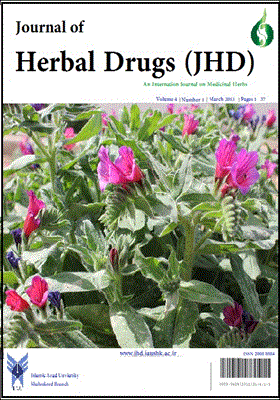-
-
List of Articles
-
Open Access Article
1 - Using elicitors for enhanced production of secondary metabolites in plant cell and organ suspension cultures
مریم محمدی فارسانی عبدالله قاسمی پیربلوطی -
Open Access Article
2 - Essential oil composition of Tanacetum chiliophyllum var. oligocephalum from Iran
مهران مجرد آشنا آباد علی سنبلی ناصر نصیری -
Open Access Article
3 - A review of pharmacological properties and functional of Cinnamon
امیرپویا قندهاری یزدی آلاله نیکویی لیلا صداقت بروجنی -
Open Access Article
4 - Effect of Gibberllic acid and Salicylic acid on Secondary metabolites in leaf of Curcuma longa L.
مریم وکیل زاده انارکی فروغ مرتضایی نژاد فریبا خلیلی محمد مهدی قیصری مهتاب اصفهانی زاده حسین پور -
Open Access Article
5 - Effects of different medium on morphophysiological traits of Lippia citriodora H.B.K. during in vitro culture condition
حسن نورافکن فاطمه سفیدکن سیدامیر موسوی مظفر شریفی احمد خلیقی -
Open Access Article
6 - The Study of Economic Dimensions of Amygdalus lycioides Production in the Charmahal-o-bakhtiyari province
محمود بخشی نژاد جمشید پیک فلک -
Open Access Article
7 - Optimization of callus induction and cell suspension cultures of Catharanthus roseus
زیبا فولادوند بهمن فاضلی نسب رضا دریکوند عبدالله قاسمی پیربلوطی -
Open Access Article
8 - Chemical composition of the essential oils Ziziphora clinopodioides collected from Tuyserkan (Hamadan), Iran
زینب دهقان سید مهدی امامی فاطمه سفیدکن
-
The rights to this website are owned by the Raimag Press Management System.
Copyright © 2021-2025







